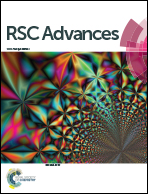Heterostructure consists of monolayer MoS2 and arsenene with novel electronic and optical conductivity†
Abstract
Two-dimensional (2D) materials receive a lot of attention due to their novel properties and wide applications. Here, we study the electronic structure and optical conductivity of new heterostructures made of two monolayers of molybdenum disulfide (MoS2) and arsenene (As). Our first-principles density functional calculations show that only the valence band of As–MoS2 heterostructures is significantly affected by the interlayer distance. Upon shortening the interlayer distance, the valence-band maximum transfer from the Γ point to Λ and Σ point, and the holes effective masses decline monotonically and lower than the electrons effective masses. Tuning the interlayer distance may change the conduction character of As–MoS2 heterostructures. In addition, the valence-band maximum and conduction-band minimum of As–MoS2 heterostructures are localized on opposite monolayers, suppressing the hole–electron recombination. Unlike transition metal dichalcogenides–transition metal dichalcogenides heterostructures, the optical conductivity of As–MoS2 heterostructure is different to its monolayers, and a new optical conductivity peak is observed in visible light region. Moreover, its intensity and position are enhanced and shifted-red with the shortening interlayer distance, respectively, due to the enlarging Fermi level with the decreasing interlayer distance. Our findings suggest that engineering As–MoS2 heterostructure is beneficial for improve the application of monolayer MoS2 in the photoelectric device.


 Please wait while we load your content...
Please wait while we load your content...